A Hebridean Journey by Land Rover: Part One
Exploring ancient ways of life on the shores of the Atlantic
The journey down this wild Atlantic coastline begins at the northernmost tip of the Outer Hebrides, where little clouds are puffing far above the Butt of Lewis lighthouse from the direction of Iceland. Clam shells are strewn high up the cliff faces. Gulls sit facing the morning sun, preening nonchalantly, oblivious to the telescopes of a pair of birdwatchers on the nearby headland.
Welcome to this first part of an exploration down the ancient west coast of the Isle of Lewis. Here you can read about my reasons for going. The second chapter is now live too.
Side note. This isn’t a faithful portrayal of modern life in Lewis. It’s simply an exploration of where the attention of a solitary traveller can wander while roaming here – the ideas, stories and questions that this landscape evoked in me.
The lighthouse at Butt of Lewis
Beginning in the 1780s, Scotland’s Northern Lighthouse Board built some of the strongest and boldest lighthouses in the world, engineered to withstand centuries of Atlantic storms without budging an inch. There’s every likelihood that most will still be standing 500 years from now. On this calm day the sea swell is barely perceptible, but as the water jostles around the cliffs you can see how much energy is contained in only the gentlest wave, if it is sufficiently long and rolling.
From a distance, a brick lighthouse might appear like a lesser cousin of its stone counterparts, but up-close the brickwork at Butt of Lewis is exquisite. Smooth and perfectly curved, it looks almost soft to the touch.
Most of the iconic Scottish examples we recognise today were the designs of Robert Stevenson and his sons, this one being engineered by David Stevenson and completed in 1862. The lighthouse keepers and their families lived in solidly-built houses surrounding the tower, growing crops and keeping their own livestock to support themselves in between occasional deliveries of oil, coal and other supplies on Northern Lighthouse Board (NLB) ships.
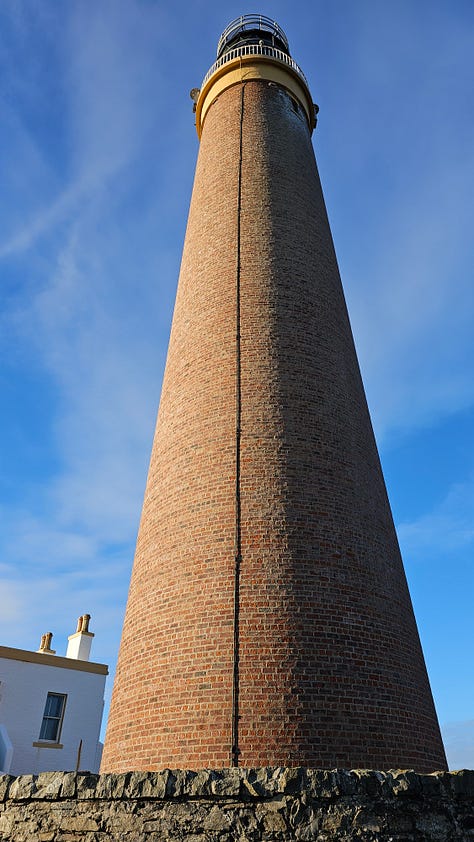
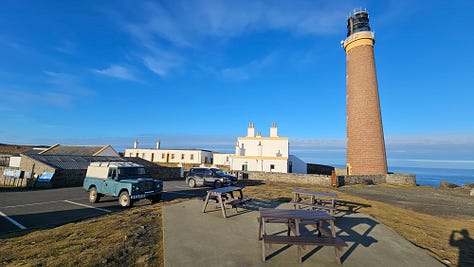
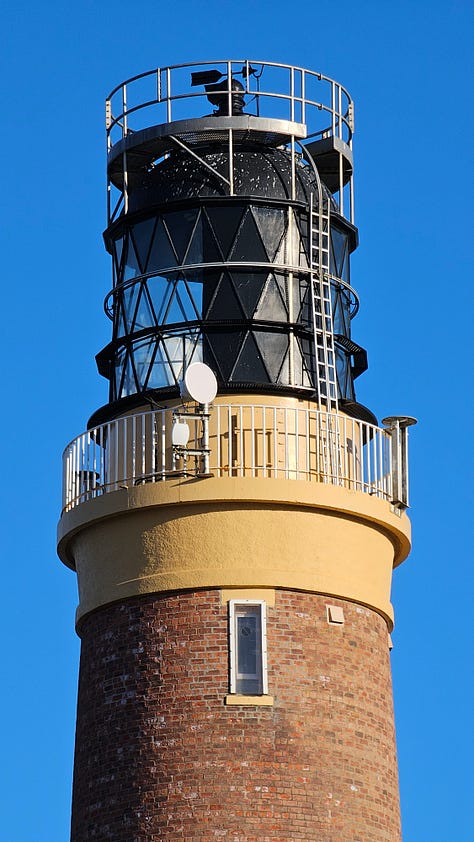
The stories of lighthouses are tales of inter-generational, disciplined regularity punctuated with occasional upheaval as new technologies replace old. This tower, like most others, was automated in 1970s so permanent attendance was no longer required. But the tower remains immaculate and fully functional – bursting its pattern of light over the sea from two banks of massive LEDs.
Thou shalt not be warmed
It’s time to fire up the Land Rover and point south. This old wagon from 1968 is affectionately known as Glug, for its numberplate as well as its awkward appetite for hydrocarbons. Glug has been a constant source of stress, joy, relief, imagination, despair and hope for the last 16 years of my ownership. During that time it’s evolved from an unfinished project into a cosmetically troubled but actually quite decent example. Since Covid it has hardly moved, despite (or perhaps because of) my best spannering, but after a recent stint with the kind of mechanic who prefers tinkering with old metal to new, Glug is now mechanically on-the-money. Actually, better than ever – which is gutting, because I really ought to sell it. (My resources aren’t a match for the things I want to do, so something’s gotta change.) I think this is to be our final journey together. Basically all I’ve ever wanted, ever since I was a kid, is the freedom to sod off in an old Land Rover I can call my own – so as Glug thrums willingly through this landscape of perfect sun and sea, I’m nursing a nasty twist of euphoria and regret.
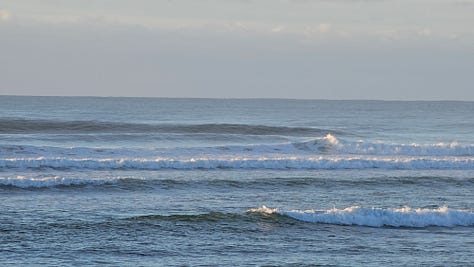
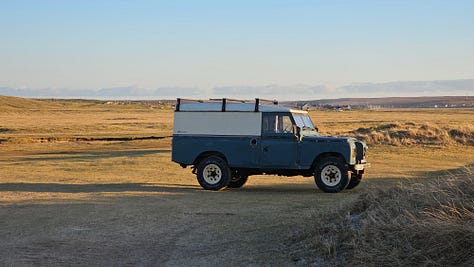
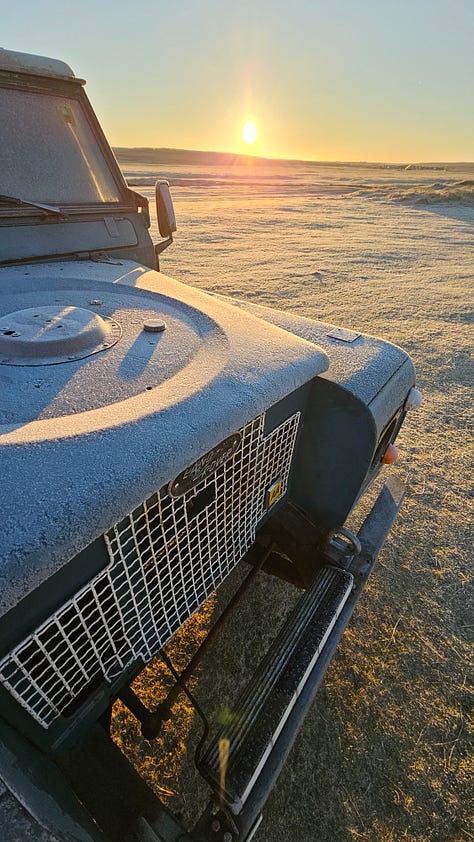
My camping spot last night (in a rifle firing range – whoops…) was bollock-quiveringly cold. The Land Rover came to rest in a serene, detached spot in the dunes at Barvas (spelled Barabhas in the local Gaelic language) where I slept in the back, in my clothes, inside a winter sleeping bag and under a duvet, and just about survived, while the jerry can of water beside me froze.
Today I’m wearing pyjama bottoms under my trousers – a life hack I discovered recently, for which I now consider myself a genius – with four top layers and a hat. I’m dying for a coffee, but my gas has run out. Of the three canisters I packed, the first lasted less than a minute, the second did nothing and the third managed to wiffle a little micro-flame for just long enough to heat some water for a pot noodle.
No chance of a hot breakfast then. In fact, no chance of anything hot all day, today being Sunday, and this being a proudly severe part of the world where no shopkeeper can jangle his keys on the Sabbath without receiving the wrath of the local columnists. In Stornoway (the island’s only real town) a few businesses are brave enough to open on Sunday, notably the Tesco supermarket, but a large banner can sometimes be seen nearby protesting in sheepishly secular terms about “profit before community” and the erosion of local tradition.
Solace, tradition, escape (and Land Rover chat)
Hundreds of years of peat cutting revealed relatively fertile, loamy soil. Houses and regimented strips of crofts line the roadside. They’re better fenced and better tended than in many areas of rougher ground elsewhere in the Hebrides. Too many crofts have been left to go to ruin in recent years, undermined by the hard economics of livestock rearing, rising property values and the high average age of the crofting population. (Crofters are as likely to be over 80 years old than under 40, earning an average of £2000 a year from their land.)
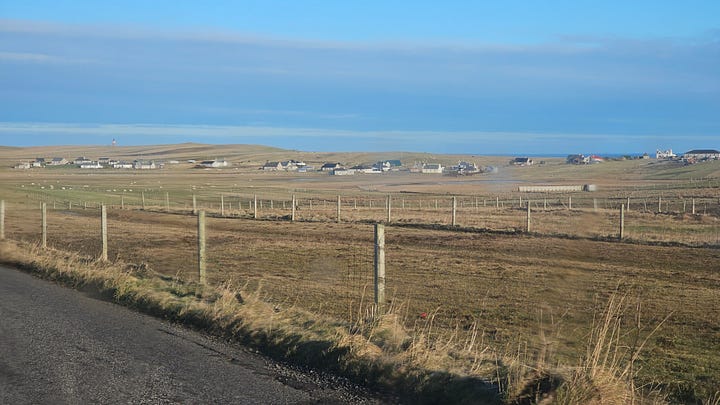

Peace and cohesion seem to linger in the air, but I think an introvert might go crazy here. Four elements seem to dominate: townships (the name for a group of crofts), landscape, sea and Church. The only respite from your neighbours is to turn your mind to the desolate moors or the wild Atlantic – or to God. “Lewis does not exist without religion,” according to some hardliners. The large church carparks are overflowing as I drive past.
And men will always seek solace in cars, even though the rain and the salty Hebridean roads make a mockery of our efforts. Rusted projects and parts donors nestle beside horseboxes and van bodies used as sheds. Crumbling pickups are everywhere. Broken Vauxhalls, an occasional ‘fast Ford’ under a sheet, maybe a Corvette... I spot a restored Land Rover 101 Forward Control GS (a 1970s V8 military derivative, designed to haul artillery across battlefields) close to a couple of broken Discovery 1s. Heading south, I pull onto the verge opposite a Td5 Defender 110 which is ‘failing to proceed’, and wonder if this might be a chance for Glug and its recovery rope to come to the rescue for the first time in years. The driver – accompanied by a mate and an excited labrador – is trying to reach the beach for a day’s surfing, but he’s been having trouble since installing a new fuel pump. He whips a wrench out of a toolbag, cranks a union on the fuel filter housing and spins the engine back into life.
“Sorry, bit greasy,” he says, extending a hand to shake.
“Don’t worry, me too.”
The mystery of Steinacleit
Not far from the road at Steinacleit, I leave my jangling water can on the bonnet to defrost in the sun and take a little walk to an ancient stone circle I’d never heard of.
This curious cluster of boulders, barely marked, has never been properly excavated. Archaeologists reckon the site is at least 3000 years old, judging by the peat which had accumulated over most of the stones before their discovery a century ago, but the exact age and purpose of this place remain unknown. A line of smaller stones encircle what has been variously described as a ‘chambered cairn’ or a ‘central homestead’ and ‘field system’. It seems an informal kind of shape, without the symmetry you might expect from a sacred site, but when I notice the perfect east/west alignment of its largest stones, the secular interpretation starts to disintegrate (perhaps revealing some silly personal bias). The tone of Historic Environment Scotland’s non-committal summary threads an effective weave of dry technicality and the warmer language of awe: “Steinacleit is enigmatic, unparalleled and mostly unknown but nonetheless it is indicative of the potential for archaeological riches concealed by blanket peat.”

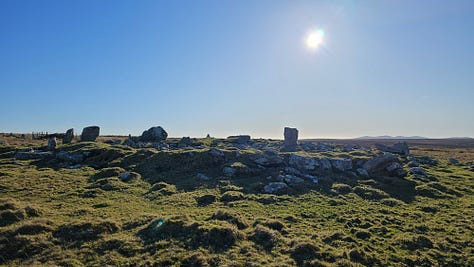
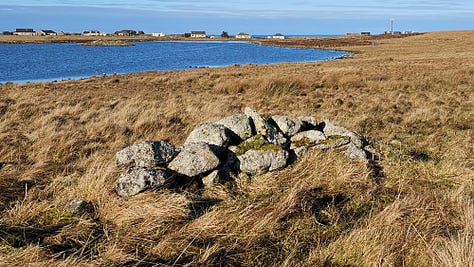
Downhill and to the west, a nearby line of rocks indicates what I assume to be a grave, and I find myself hoping it escapes the excavation that seems so inevitable for the circle nearby. How old does a grave have to be, how anonymous the remains, for us to justify a dig, carting off the pieces in ziploc plastic and pouring over them for TV documentaries? Why does excavating the crushed corpses of Pompeii seem an obvious exercise, and yet scraping aside this person’s grave marker (two centuries or two millennia old) to unpick their remains from the earth feel like sacrilege?
Flour for a thousand years
Near Shawbost, a few miles further south, I step on the brakes and lurch off the road at a brown sign marked “Norse Mill and Kiln”. (Here on the map.) A stony footpath leads out of sight to a couple of tiny stone buildings with thatched and netted roofs beside a gurgling burn. It’s a nestled, tranquil spot, though surely teeming with airborne bloodsuckers in summer.
A thousand years ago, we might have heard the grind of a millstone here, and the dull roar of a crackling oven. One building, used for drying grain, contains a circular fire pit. Inside the other, a diversion of the burn directs water through a stone chute, powering a set of wooden paddles which rotated the millstones against each other. Above is a reconstructed wooden hopper which fed the gain into the centre of the stone. Today the water channel is clogged and the subterranean mechanism is starting to fall apart.
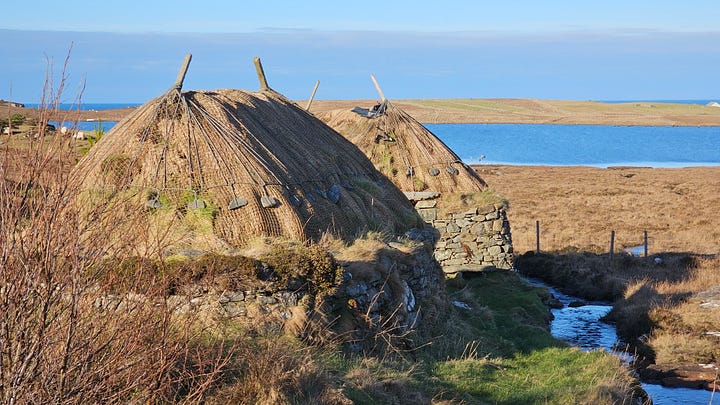

Although restored in the 1960s and again in the ’90s, the buildings originate from the islands’ period of Scandinavian rule (the years 872 to 1266) and, incredibly, were in use until the 1930s. People were still feeding their families here while physicists and warmongers were theorising about the creation of the first nuclear warhead.
I return to the Land Rover to find a couple of young guys parked in hot-hatches – well, mildly warm ones – apparently for the sole purpose of staring at their phones and winding up the volume on a thumping remix of that song by the Black Eyed Peas about their optimism for the ‘good, good night’ ahead. (Ever tried singing that without the syncopation? It sounds totally asinine, and I can’t decide whether that makes the original version daft or ingenious.) Glug, sans power steering, manages to heave a seven-point turn around their vacuous presence, and we bumble on southwards.
I’ve one more stop today.
The Callanish Stones
I think it’s no exaggeration to describe the Callanish (Calanais) Stones as one of the most evocative and spectacular megalithic structures in the world. The main ring is easily the most beautiful in the UK, older than Stonehenge and almost as bewildering. It is five thousand years old.
A £10m visitors’ centre is now under construction, and I’m sure a lot of clever research has been done to show how obvious and necessary it all is. The website is a laborious barrage of buzzwords. Personally I’m just glad to have known this place from before the latest ‘development’.
I pay a visit to some of the smaller circles that were set around this sea inlet. Clearly it was a focal point for something, presumably spiritual worship, although opinions differ and nobody really knows. The imagination runs riot with what might have been. There are so few tangible clues, and none of the explanations I’ve encountered seem very convincing. All we know is that, for thousands of people living here over a 1500-year period, this was probably the centre of their world.
And today there’s absolutely no one here.

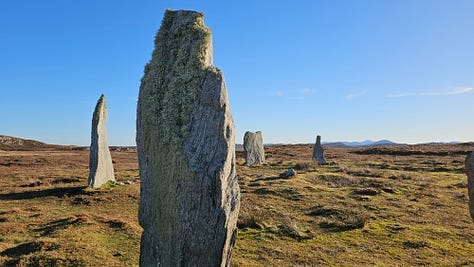
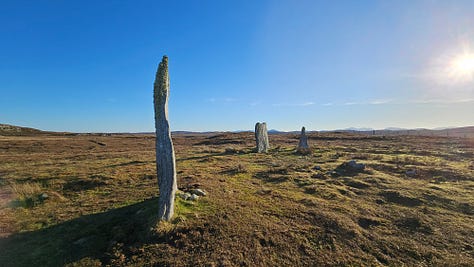
Only a few stones of Callanish 2 survive – miraculously thin and jagged, tall and upright, echoing human forms in permanent consultation. The more substantial Callanish 3 is a short stroll away over marshy ground on a broken wooden walkway (that wouldn’t cost £10m). The Ordnance Survey map is wrong about the routing for the alternative north/south path. Let it stay wrong.
On closer inspection, the little metal gates – which I’d mistaken for having been picked up at the nearest garden centre – incorporate little stick men heaving stones into position. It’s a discrete and expressive way of incorporating fun and artistry into something functional, concretising a spirit of appreciation and care. A lot of public art leaves me cold, but this I love.
The Iron Age house at Bosta
Plugging most of the sea loch at Callanish is the island of Bernara (Beàrnaraigh), just 100m offshore and accessed over a modern bridge. (Technically this is Great Bernera, but it’s generally known simply as Bernera.) I have my sights set on this island’s furthest point, lured by the promise of an iron-age dwelling at Bosta (Bostadh). It’s here on the map.
The road ends at a cemetery, and beyond it you walk down to the back of a sheltered sandy beach to find – nestled down between hillsides and half-buried in the earth – a perfect replica of an iron-age home. Five dwellings were uncovered here in the 1990s, along with pottery and bone artefacts. Leaving them revealed would have made them vulnerable to collapse from the shifting sands, so four were re-filled, and the fifth was built again using the same materials and methods that would have been available to the people who originally lived here between approximately 400 and 800 AD.
It’s a domestic, sheltered setting. This evening it feels like an enclave of paradise, peaceful and secure, but on a soggy or midge-infested day I imagine a dismal gloom might descend.
The houses were all dug down into the earth, with a door accessed by descending steps. (I expect the sandy soil is what makes this possible without causing in a frequent flood at the door.) A simple timber roof, layered with green turf, extends down to the ground. A perimeter wall closely circles the house, protecting it from the wind and perhaps also preventing livestock from munching on the roof.
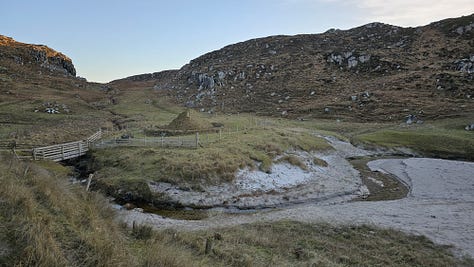
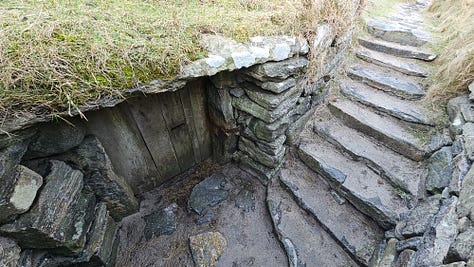
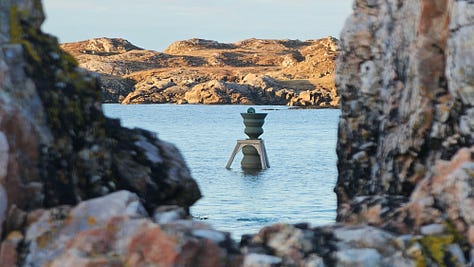
Places like these can remind us of the simplicity of our true material needs, and the vanity of much modern busyness. Almost all our attention is spent (and increasingly taken) in very different ways to that of our ancestors; we rely entirely on objects and systems and concepts that would be alien to them. I try to imagine myself living then, worn out by my 36 winters. Perhaps I arrived and settled at Bosta from far away, or perhaps my whole existence has been rooted to this spot and the people who share it, and those who come and go, friend and foe. Spicy food, levers, glass windows, books... I have no comprehension of any of these. Luxuries on the periphery of my experience might include lanterns, wheels, bees, chain, glass, perhaps apple trees. The idea that the self-reliant inhabitants of Bosta should pay taxes to the bewigged lawmakers of some faraway city would seem totally bizarre. Criminal, even.
A wave-catcher bell was installed here in 2010, concreted to a rock just offshore. In this calm sea it’s silent, thankfully. I’m sure it’s much loved, but it’s a spooky-looking thing. Three legs give it a Triffid-like, almost humanoid silhouette – faceless yet somehow always staring your way.
At dusk, as I scrape together a few cold ingredients and consider an early night in the Land Rover, another Vauxhall speeds over the headland. More subwoofer enthusiasts I fear, but it pulls up with an urgency that indicates its driver has something he needs to do. His girlfriend leaps out, skips away around the cliffs, and he goes trotting after. After a predictable interval they reappear, whooping inexplicably, and looking not quite as chilly as me.
Thank you for reading. The second and final part of this journey, covering Bernara to Mealasta, will be published soon for my paying subscribers.





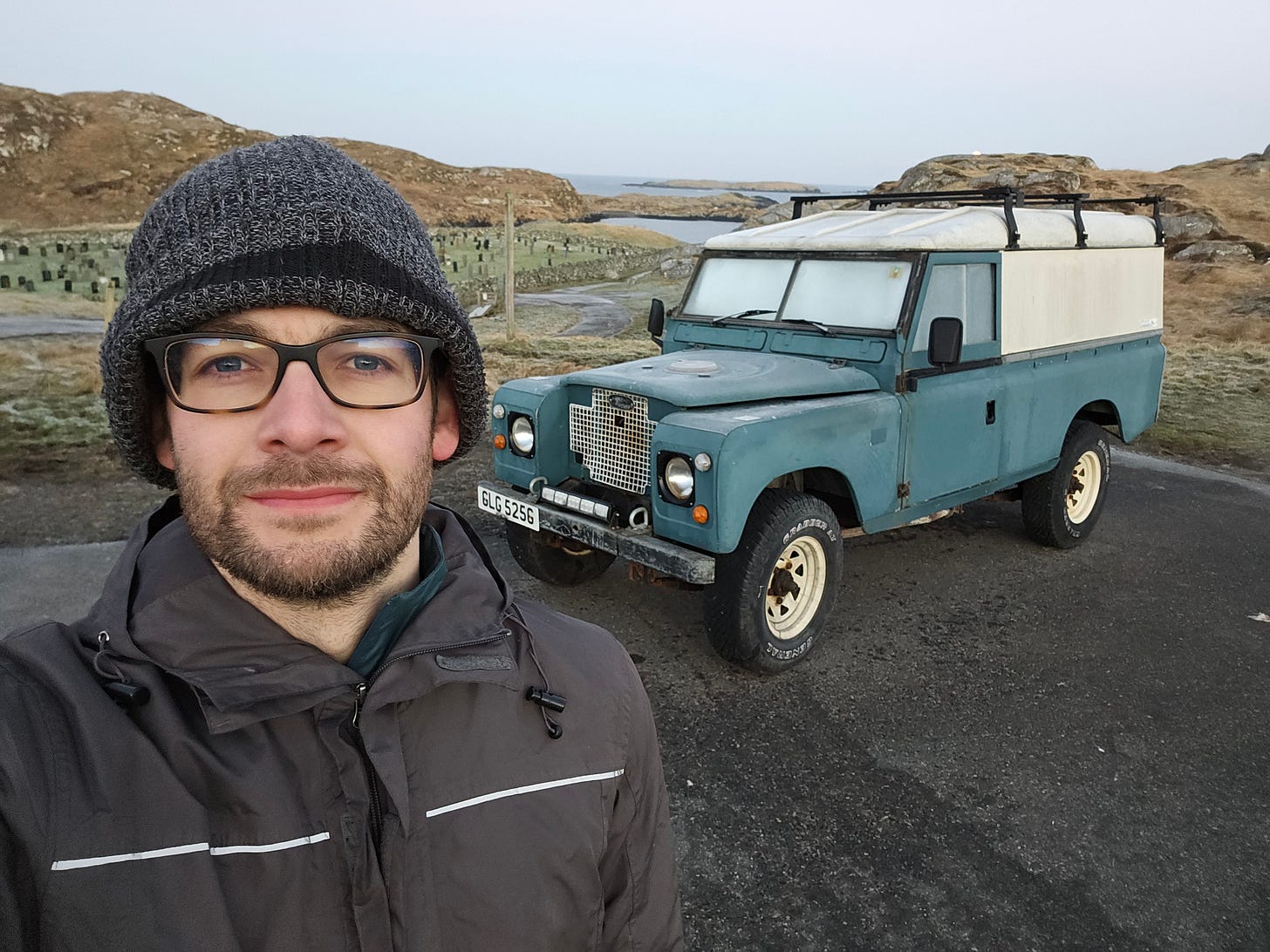
And also, are there pubs where people hang around? I remember one village in Ireland where there were 5 houses ans 3 of them were pubs. I think Scots are similar?
How many tourists or other campers you meet on thr way? Also, was this in the Summer or recently? Camping must be cold… thank you for this account!